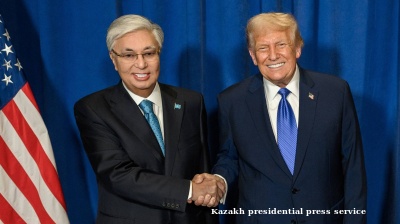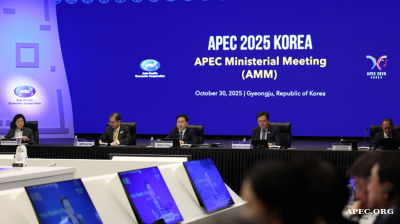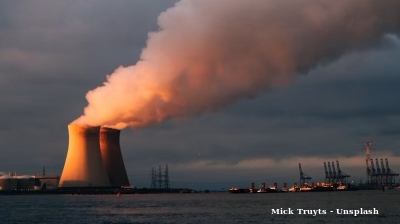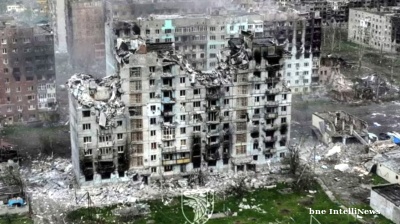Widely seen as a marriage of convenience, economic ties between Russia and China are rapidly deepening as the two countries are driven together by pressure from the West.
As Nato foreign ministers gathered in Bucharest to show solidarity with Ukraine in its fight against Russia, top politicians and business leaders met for a Sino-Russian summit to pledge deeper cooperation and celebrate the rapidly expanding business ties, led by trade in energy.
"China is becoming the largest consumer of Russian energy. This year, trade turnover in the energy sector has grown by 64% compared to last year, in physical terms, deliveries have grown by about 10%," according to Russian Deputy Prime Minister Alexander Novak, speaking at the fourth Russian-Chinese Energy Business Forum held this week.
China has been following a difficult path, supporting Russia’s clash with the West on one hand, but trying to avoid bringing down sanctions on itself on the other as the EU and US account for over $1 trillion worth of its trade every year.
And while Beijing has avoided supplying Russia with military equipment and its banks have shunned their Russian counterparts, that has not stopped trade from booming, driven by a huge increase in oil imports, amongst other things. Russian President Vladimir Putin and Chinese President Xi Jinping set themselves a goal of increasing their mutual trade turnover to $200bn by 2024 a few years ago, up from around $100bn before the war, and that goal is likely to be achieved this year.
Trade
Sanctions have cut Russia off from the EU which was its main supplier of goods until the war started, with machinery making up around half of all those imports for the last two decades. Now sanctions, and more importantly self-sanctions, have seen European imports slow to a trickle, Russia has turned to China for help.
Trade between Russia and China topped $140bn in 2021 but fell hard during the first months after Russia’s invasion of Ukraine this year. But since then, it has bounced back and is on course to end 2022 at around $190bn – just shy of the two presidents’ goal – with the total trade turnover reaching $154bn as of the end of October.
Oil remains the biggest item on the list as China became the largest consumer of Russian energy resources this year. Bilateral trade turnover has increased by almost two thirds in financial terms since the start of this year compared to last year, Novak said.
"Amid the global energy crisis, the trade and economic relationship between our countries represents stability and growth. China topped the list of Russia’s trade partners in 2021. In ten months of this year trade turnover between Russia and China reached $153.9bn, up by 33% in annual terms. With those rates maintained, trade turnover may reach a record $180bn-190bn by the end of this year," he said.
Russian oil exports to China gained 9.5% y/y by October to almost 72mn metric tonnes, CEO of the Russian oil major Rosneft Igor Sechin added, making Russia the second-largest fuel supplier to China, behind only the Kingdom of Saudi Arabia (KSA) with 73.8mn tonnes.
Gas exports are booming but remain a fraction of the gas that Russia sends to the EU. As part of the divorce from the EU, Russia hopes to reorientate its gas exports eastward, but currently has only one pipeline carrying gas to Asia, the Eastern Siberia-Pacific Ocean (ESPO) pipeline. Nevertheless, piped gas to China has increased by 60% this year, Novak said.
Russian LNG exports to China have also been climbing. Russia’s deliveries of LNG may equal those of piped gas in the near future, according to Sechin, adding that pipeline gas supplies to China would exceed 100mn cubic metres in the near future.
Russia is on course to export a total of 15 bcm of gas to China via the Power of Siberia 1 pipeline in 2022 – still only a tenth of what Russia normally exports to Europe – but the total capacity of existing and planned gas pipelines from Russia to China is 100 bcm, which equals 27% of China’s gas consumption last year and would go a long way to replacing the EU as Russia’s main gas customer.
"Russia’s pipeline supplies of gas to China will surpass 100bn cubic metres per year in the foreseeable future,” Sechin said without providing a timeline. “That said, the potential of the Russian resource base of natural gas is substantially higher than those volumes.” The issue is both about gas reserves in Eastern Siberia diverted from the European direction and about a vast resource base in Russia’s east, according to the CEO. Rosneft has an estimated 2 trillion cubic metres of gas in its gas reserves in Eastern Siberia and the Far East, Sechin said.
China is also increasingly reliant on Russian coal, which remains the main fuel burnt in its power stations. Russian coal supplies to China amount to almost a quarter of Chinese imports and stood at 53mn metric tonnes in January-October 2022. Russia is the second biggest supplier of coal to China, accounting for a quarter (23%) of its supplies, second only to Indonesia.
Earlier, the head of the Russian energy ministry’s coal department Petr Bobylev told TASS that Russia was negotiating an increase in coal supplies with China.
In addition, Russia is boosting its cross-border power exports to China, which were up by a third (33%) to almost 4bn kWh in the first ten months of the year, setting a new record over the first ten months of this year, Tass reports.
"[State-owned utility] Inter RAO has boosted electricity supplies from Russia to China this year amid abnormal heat and energy deficit at the request of the Chinese side. In January-October supplies rose by 33% y/y to almost 4bn kWh," he said. Inter RAO told Tass that Moscow and Beijing have recently signed an agreement to increase Russia’s electricity exports to a record 4.4bn kWh in 2022 and Novak added that power exports may rise another 11% by the end of this year.
"The monthly volumes of supplies have been doubled at the request of the State Grid Corporation of China. We expect an increase in supplies by 11% by the end of the year," he said.
In a quid pro quo, China opened its grain markets to Russian imports in the first weeks after the war started, something that the Kremlin has been lobbying for for years.
And China has rushed into the space left vacant by the departing Western firms. China is bolstering its share on the Russian retail market and tapping into new niches, Russian ambassador to Beijing Igor Morgulov told Tass on November 17.
"The exit of many Western corporations from our country has provided Chinese companies with the opportunity to increase the share of their products and to tap into new niches on the Russian market, which I expect they will use," he stressed. "In fact, the process is underway already.” Russia’s diplomatic mission and trade mission are providing help to China in every possible way, he noted.
Exports of agricultural products from Russia to Asian countries in January-October 2022 increased by 14% compared to the same period in 2021, according to Agroexport center under the Russian Ministry of Agriculture.
According to Agroexport, the supply of fish and seafood, sunflower and rapeseed oil, poultry meat, and a variety of other items to this region have increased. In particular, China in 2022 retained the second place among the buyers of Russian agricultural products. According to analysts, in the first 10 months of 2022, agricultural and food products were exported from Russia to China by 34% more than in the same period in 2021. This was partly owing to a surge in rapeseed oil sales, which climbed 2.2-fold and became the biggest category in Russian supplies to China. Frozen fish came in second, with supply increasing by 81%.

New export infrastructure
Looking further down the road, Russia and China are already looking to expand the energy infrastructure connecting their two economies.
Some gas is already transported by the Eastern Siberia-Pacific Ocean (ESPO), but it can carry at most about a tenth of the 155bcm of gas Russia used to send westwards before war. There are already plans to double ESPO’s capacity that can be built relatively quickly, and a second Soyuz-Vostok pipeline via Mongolia is also planned. But the biggest project is the Power of Siberia 2, an extension of the existing pipeline of the same name that would connect the massive gas fields in Yamal with China. “Active” talks have already begun, but analysts say that it will take at least a decade for Russia to pivot its oil and gas infrastructure from West to East. In the meantime Russia has been boosting its sales to China by any means it can.
Russia’s pipeline supplies of oil to China amounted to 33mn tonnes in January-October, which is around last year’s level, vice president of CNPC (China National Petroleum Corporation) Huang Yongzhang said at the Russian-Chinese energy business forum.
"In the first ten months of 2022, 33.26mn tonnes of oil were imported via pipeline from Russia to China," he said.
The countries have extended the agreement on oil deliveries to China’s west, which will ensure the supply of 100mn tonnes of oil within the contract term, according to the vice president.
Delivery of oil by ship is also up by a quarter (25%) in the first nine months of this year to 87.5mn tonnes, Russian Deputy Minister of Transport Alexander Poshivai said at the forum.
"In the first nine months of 2021, 70mn tonnes of hydrocarbons were exported from Russia to China. In the first nine months of 2022, 87.5mn tonnes of energy resources were carried by sea transport, which is 25% higher than in the same period last year. The increase was mainly due to oil shipments," he said.
Last year more than 20 vessels were built at Chinese shipyards for Russia, the official added, noting that another two ships are being constructed now. Russia’s own oil tanker fleet numbers a bit more than 80 vessels, but Russia continues to rely overwhelmingly on the Greek fleet that carries a bit more than half of all Russia’s seaborne oil exports.
Hunt for equipment
The Western energy sanctions have proven to be ineffective so far, but the ban on exporting equipment to Russia is almost complete and sent energy companies scurrying around the world to find alternative suppliers. Novak said that Russia and China plan to jointly produce equipment for the energy industry as part of their growing cooperation.
"China is one of the key manufacturers of equipment in the oil and gas sector. There is already close cooperation on the supply of oil and gas equipment for projects in Russia," he said. "We plan to jointly work on the development and production of equipment that can be used both in China and in Russia," Novak added.
There are similar plans to boost trade with India as Moscow seeks to enhance trade with all the “friendly” nations to replace imports from the unfriendly ones.
Sanctions-hit Moscow reportedly sent India a list of at least 500 different products it urgently needs, including parts for cars, aircraft and trains, Reuters reports, citing four sources familiar with the request.
Russia's Ministry of Industry and Trade asked Indian companies to provide lists of raw materials and equipment as they scour the world for inputs they used to buy in Europe.
Car parts are in particular demand as Russia’s automotive sector has all but ceased to function as car production was up to 60% dependent on imported parts that have stopped arriving. The Russian ministry sent a 14-page list of desperately needed car parts, including engine components such as pistons, oil pumps and ignition coils, as well as bumpers and seatbelts, to corresponding ministries and state agencies in other countries, including India, Reuters reports.
Russia reportedly also asked for 41 items for aircraft and helicopters, including gear components, fuel, communication and fire extinguishing systems, Reuters said.
Oil price cap scheme
The next test for Sino-Russian relations will be the West’s attempt to impose an oil price cap scheme on Russian oil exports, which will be enforced by refusing to grant insurance policies to ships that ignore the caps.
India and Turkey have both said they will recognise Russian insurance as coverage, effectively ignoring the sanctions, but China, afraid of US sanctions, has been more circumspect.
Turkey recognises the insurance certificate of Russian companies for marine transportation, though India and China honour them but not completely, Russia’s Deputy Minister of Transport Alexander Poshivay told reporters at the summit.
"Yes," the official said, answering a question from reporters. "India and China recognise [them] largely, but not completely," Poshivay noted, without giving more details.
China does not yet recognise protection and indemnity insurance, more commonly known as P&I insurance, and reinsurance certificates issued to shipowners by Russian insurers, according to Poshivay. The Central Bank of Russia (CBR) has recapitalised the Russian National Reinsurance Company (RNRC) to give it the financial firepower to be able to adequately insure marine transport, but the issue of accepting this insurance remains highly politicised.
“RNRC increased its authorised capital to RUB750bn ($12.5bn), but now it is actually almost unlimited. The Central Bank is a guarantor for RNRC, that is, reinsurance guarantees can be applied to any volume of Russian oil and oil products,” Poshivay said, noting that practice is needed for successful work.
Features

Indian bank deposits to grow steadily in FY26 amid liquidity boost
Deposit growth at Indian banks is projected to remain adequate in FY2025-26, supported by an improved liquidity environment and regulatory measures that are expected to sustain credit expansion of 11–12%

What Central Asia wants out of the upcoming Washington summit
Clarity on critical minerals and a lot else.

Global leaders gather in Gyeongju to shape APEC cooperation
Global leaders are arriving in Gyeongju, the cultural hub of North Gyeongsang Province, as South Korea hosts the Asia Pacific Economic Cooperation summit. Delegates from 21 member economies are expected to discuss trade, technology and security.

Project Matador marks new South Korea-US nuclear collaboration
Fermi America, a private energy developer in the United States, is moving ahead with what could become one of the most significant privately financed clean energy projects globally.




